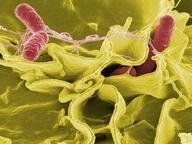Quiz Answer Key and Fun Facts
1. The humble flea, bane of the unclean pet, is the animal kingdom's long jumping champion. It is also responsible for approximately 200 million human deaths, more than all wars combined, due to it spreading which disease?
2. Sarcoptes scabiei lives its entire life on its human host, its lifecycle varying from between 10 and 17 days. The female digs burrows into the skin in which to lay eggs, eating the skin and fluid she excavates. When the mite's eggs hatch, the larvae clamber to the surface whereupon they dig themselves a burrow of their own in which to molt. An infestation of these mites is referred to as what?
3. It is estimated that about 200 million people worldwide have these little fellows swimming about within the veins of the abdominal cavity. They can happily eat and mate for up to 20 years, producing hundreds of eggs every day. An estimated 1 million people a year die from complications attributed to Schistosoma mansoni, Schistosoma haematobium and Schistosoma japonicum. What other name are these beasties known by?
4. This little flea is not content with grabbing a quick bite and heading off. Oh no, it knows when it's onto a good thing; having found a meal it isn't about to give it up. Tunga penetrans burrows below the surface into cutaneous and subcutaneous tissues and isn't likely to leave without surgical assistance. What is the common name for this flea?
5. It is estimated that around 25 percent of the world's population is infected with Ascaris lumbricoides. The parasite can live its entire life snuggled happily in our innards.
The adult dwells in the small intestine, where a female can produce a lazy 200,000 eggs per day. When the eggs hatch within the small intestine, the youngsters burrow into the circulatory system and swim their way to the lungs. From there they crawl up to the pharynx where they are swallowed and end up back where they started! What is Ascaris lumbricoides also known as?
6. Don't let the bedbugs bite. We've all heard that goodnight advice. What's wrong with letting bedbugs sip some of your blood while you're asleep?
7. The body louse causes irritation and itching but does not transmit disease.
8. Entamoeba histolytica to scientists, to us it's an amoeba which causes gastrointestinal complaints such as diarrhea and even dysentery. During the feeding stage of the amoeba's lifecycle they are known as a trophozoites. It is during this stage that the amoeba snacks on our innards. Specifically what do they feed on?
9. Ancylostoma duodenale and Necator americanus are estimated to infect some 800 million people worldwide. The larvae of these creatures live in soil until they come into contact with a host. They then burrow through the skin, generally a bare foot, and make their way to the intestines. Living hooked firmly onto the small intestine of the host, these parasites feed on the host's blood. Severe infection can cause serious problems for the host, especially in infants and young children, due to blood loss alone. What are Ancylostoma duodenale and Necator americanus also known as?
10. Fat, bloated ticks love nothing better than to bury their tiny heads into your skin and drink. The tick is infamous for spreading any of a number of diseases, including Lyme disease, encephalitis and Q-fever. Encephalitis is a viral disease; what causes Lyme disease?
Source: Author
quogequox
This quiz was reviewed by FunTrivia editor
crisw before going online.
Any errors found in FunTrivia content are routinely corrected through our feedback system.


